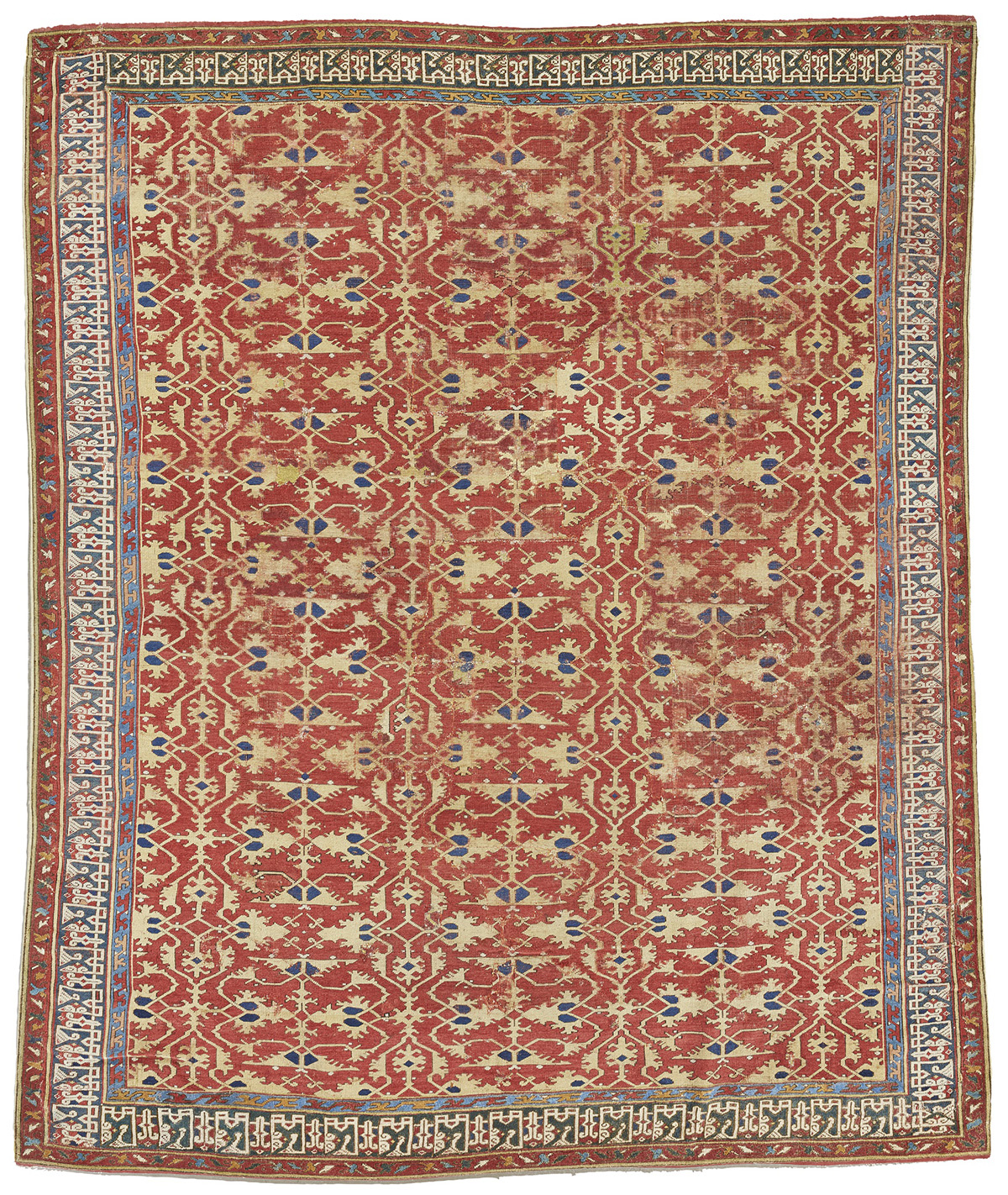|
XVI
century Turkish rug with the so called "Lotto" design,
Western Turkey, Ushak Region, Ottoman Empire. Eskenazi Collection.
Laer Chris Alexander Collection. Formerly Wildenstein Collection. 228x226cm.
Sotheby's Rugs and Carpets
London | 07
Nov 2017, 02:30 PM | L17872
LOT 122
PROPERTY FROM THE
ALEXANDER COLLECTION
AN OUSHAK 'LOTTO' CARPET, WEST ANATOLIA
with 'Anatolian' style field and 'Holbein' or 'Kufic' border design,
reduced in length
approximately 270 by 230cm; 8ft. 10in., 7ft. 7in.
first half 16th century, possibly earlier
ESTIMATE
30,000-40,000 GBP
SOLD 81,250 GBP
LITERATURE
Alexander, C., A Foreshadowing of 21st Century Art The
Color and Geometry of Very Early Turkish Carpets, New
York, 1993, pp.
228 - 229, ill. pp. 187 (detail) & 229.
Eskanazi. J., Il tappeto
orientale dal XV al XVIII secolo, London, 1982, pp. 29, 30, 72. tavaola.
7.
CATALOGUE NOTE
'Lotto' carpets derive their name from the
Renaissance painter Lorenzo Lotto, (c. 1480 – 1556), who depicted an
example in ‘The Alms of St. Anthony’, 1542, Venice, although they also
appear in earlier paintings. Whilst all these
courtly works are
termed ‘Lotto’ there are three differing types of sub design - ‘Kilim’,
‘Ornamented’ and ‘Anatolian’.
The latter two examples are widely
agreed to be the earliest and therefore with the least surviving
examples: the
present carpet is an ‘Anatolian’ design. This
established through the various ‘Substrate’ geometric designs within the
field, which are interestingly, in part, shared by the Tabriz gallery
carpet, lot 89 also noted by Alexander,'
Foreshadowing', op.cit., pp.
186 & 187. For a detailed discussion of the group and the differing
designs see Robert
Pinner’s article ‘Multiple and Substrate Designs
in Early Anatolian & East Mediterranean Carpets’, Hali, 1988, issue
42, pp. 27 -30.
It is owing to these 16th century artworks that
we can, with conviction, date these highly colourful and ornate works of
art. A thorough study of ‘Lotto’ carpets which appear in such paintings
was conducted by John Mills, ‘‘Lotto’ Carpets in
Western Paintings,
Hali, winter 1981, vol. 3, no. 4, pp. 278 – 289. Of the many examples
Mills cites one, in particular,
is shown in the Annunciation, Master
of the Retable of Santos - o - Novo, circa 1520, Museo Nacional del
Arte, Mills.
J., op cit, p. 279, fig. 2 and also in A Foreshadowing
of 21st Century Art, which shares both the ‘Anatolian’ field and
also
the ‘Kufic’ or ‘Holbein design border. Another very similar example of
an 'Anatolian' Lotto carpet, sharing the
green 'Holbein' border and
light blue inner border can be seen in the Thyssen-Bornemisza
Collection, Sphuler. F.,
The Thyssen-Bornemisza Collection Carpets
and Textiles, London, 1998, pp. 28 - 31, pl. 1. This example, also
reduced in length, shares three columns of 'ornamented' motifs and lacks
the madder and polychrome outer minor
border, however the traced in
and out leaf pattern found in the inner blue border of the Thyssen
example is repeated
in the outer madder border of the offered lot.
'the best and earliest 'Lotto' carpets display a brilliant red and
luminous yellow as well as light blue and green tones'
Spuhler. F.,
op.cit., p. 31.
Spuhler also states that this ‘Kufic/Holbein’
border design is typical of early 'Lotto' carpets and derives from
Seljuk art
work. The ‘Kufic’ calligraphy traces back to the 7th
century and an example of the relationship between it and the
carpet
design can be seen in the 15th century ‘Scroll of Sultan Mehmet II’ in
the Topkapi Sarayi Muzesi, Istanbul,
E.H.2878, pictured Bac. S. &
Tanindi. Z., Turks A Journey of a Thousand Years, 600 -1600, London,
2005, pl. 246.
Interestingly 'Lotto' design seems to predate the
Ottoman rumi-hatayi, courtly style, of Baba Nakkash and is derived,
as with 'Holbein' carpets, from the Timurid Empire, Suriano. C. M.,
'Patterns of Patronage, Hali, October/November,
1983, issue 83, p.
84. Examples of this particular genre of ‘Lotto’ are now in museum
collections across the world,
other than those previously cited,
examples include: The Philadelphia Museum of Art, acc. nos. 1955-65-9,
1967-30-
308 & 1943-40-68, illustrated C. G. Ellis., Oriental Carpets
in the Philadelphia Museum of Art, London, 1988, pp. 22 -
29, pls. 6
- 8. Also a fragment in the Islamisches Museum, Berlin, which bears such
a likeness to the offered example
that it is possible that it was
originally a part of it, acc. no. 1875,224. Such examples, of this type,
rarely come to
auction however a comparable 'Lotto' was sold
Sotheby’s New York, 14 December 2001, lot 48.
|


.jpg)
.jpg)
.jpg)
.jpg)
.jpg)